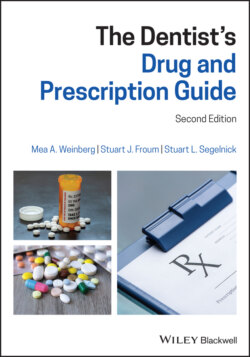Читать книгу The Dentist's Drug and Prescription Guide - Mea A. Weinberg - Страница 12
2.2 Generic Substitution
Оглавление1 Q. When does a brand name drug become generic?
2 A. A brand name drug can become generic when the patent for that drug expires. Once the brand name drug goes off‐patent, several drug companies can begin to manufacture a generic equivalent drug. In the United States, one company is given 180 days of exclusivity to manufacture a generic version of a drug. After 180 days, other manufacturers of generic medications can then start to make their own generic form of the drug. For example, the patent on Celebrex® expired in 2013. Until 2013, Celebrex was not available in a generic form (www.fda.gov/Drugs/DevelopmentApprovalProcess/ucm079031.htm).
3 Q. At the bottom of the prescription there is a section that says “dispense as written” or “substitution permissible.” What is the difference between a generic drug and a brand name drug?
4 A. A generic drug is manufactured and distributed usually without a patent. However, the generic drug may still have a patent on the entire formulation but not on the active ingredient. A drug that has a trade (brand) name is protected by a patent whereby it can only be manufactured and sold by the company holding the patent. Once the patent expires (between seven and 12 years) on a brand name drug, the generic form becomes available (Welage et al. 2001).
5 Q. What is generic equivalency?
6 A. Generic equivalency was developed to save consumers and insurance companies high costs. Generic drugs are much cheaper because of competition between drug manufacturers once the patent has expired. Also, it costs less to manufacture generic drugs. Many brand name drugs have less expensive generic substitutes that according to the FDA are therapeutically and biochemically equivalent to the brand name drug. The FDA requires the bioequivalence of the generic drug (active ingredient) to be between 80% and 125% of that of the brand name drug. Generics are considered by the FDA to be identical in dose, strength, safety, efficacy, and intended use (Balthasar 1999; Greene et al. 2001; Meridith 2003).
7 Q. Is a generic drug always equivalent to a brand name drug?
8 A. According to the law, drug companies are required to prove bioavailability. Many drugs that are available generically are equally efficacious with the equivalent brand name (Birkett 2003).
9 Q. What is generic substitution and how do I know if a generic drug substitute is available?
10 A. Generic substitution is the process by which a brand name drug is dispensed by a different form of the same active substance (Posner and Griffin 2011). There is a book called the “Orange Book: Approved Drug Products with Therapeutic Equivalence Evaluations” that all pharmacies have, and since February 2005, there has been a daily Electronic Orange Book (EOB) product information for new generic drug approvals. The downloaded Annual Edition and Cumulative Supplements are also available in a paper version (Approved Drug Products with Therapeutic Equivalence Evaluations, ADP 2008) from the US Government Printing Office: http://bookstore.gpo.gov; toll free telephone number 866‐512‐1800.
11 Q. How do I write for a generic substitute on a prescription?
12 A. Prescriptions have instructions on whether the prescriber will allow the pharmacist to substitute a generic version of the drug. This instruction is communicated in several different ways which differ among states. Usually, the prescription contains two signature lines. One line has “substitution permitted” or “substitution permissible” printed at the bottom of the prescription and the other line has “dispense as written” or “do not substitute.” The prescriber signs either line. Some states have a “daw” (dispense as written) box printed at the bottom of the prescription. This means that the prescription will be filled generically unless the prescriber writes “daw” in the box, in which case the prescription will be filled the way it is written by the prescriber. For example, if you write a prescription for the trade name of a drug such as Vibramycin® (the patient only wants to take a brand name drug) and sign the line “do not substitute” or write “daw” in the box, the prescription will be dispensed with the brand name drug rather than the generic substitute (doxycycline) (Meridith 2003).
13 Q. When should a generic drug rather than a brand name drug be prescribed?
14 A. Any time. It is the decision of the patient. Most drugs today are dispensed as generic. Generic substitution is intended for the pharmacist to use a form of the drug which may be less expensive to the patient. It is usually the cheaper drug yet still has the same FDA guidelines in manufacturing and should be equal in efficacy to the brand name drug. However, if the prescriber writes a prescription for the brand name drug and signs “do not substitute,” the patient cannot request the generic (Food and Drug Administration [FDA] – Center for Drug Evaluation and Research [CDER]. Statistical approaches to Establishing Bioequivalence 2001).
15 Q. Who decides to choose a generic substitute?
16 A. The patient makes the decision as long as the prescription is signed by the prescriber to allow for substitution. If the prescriber does not sign the appropriate place to allow for generic substitution, the pharmacist must dispense the generic.
